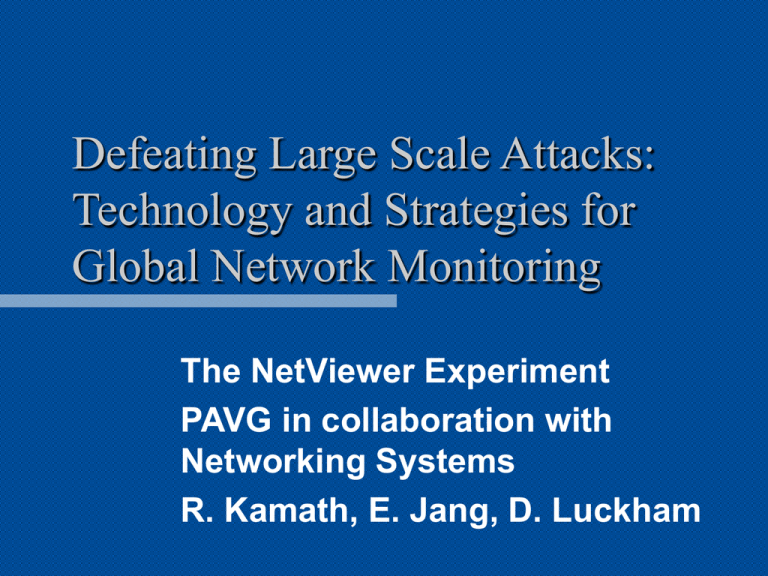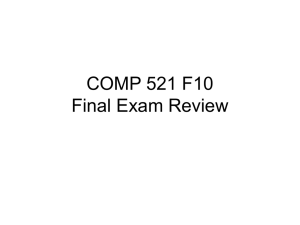Project Overview - Real Time Intelligence & Complex Event
advertisement

Defeating Large Scale Attacks: Technology and Strategies for Global Network Monitoring The NetViewer Experiment PAVG in collaboration with Networking Systems R. Kamath, E. Jang, D. Luckham Project Goals Detect system misuse on a global level User re-configurable and flexible Hierarchical organization of monitors Correlation of distributed monitors Monitor activity from diverse sources Monitor at multiple levels of abstraction 2 Stanford NetViewer Experiment Uses Stanford Rapide Toolset Uses Complex Event Processing technology Uses Talarian’s SmartSocketsTM middleware for distributed processing FOR MORE INFO... Http://pavg.stanford.edu/rapide Http://pavg.stanford.edu/cep 3 NetViewer Experiment setup NetFlow FlowCollector Intrusion Monitor Map CEP Logger Flow Efficiency Monitor Filter Map PassThrough Monitor Log Files Cisco NetFlow FlowCollector Complex Event Processing Monitor Views 4 SUNet Campus Network Internet Core Gateway Undergrad Education Redundancy Gateway Grad. Education Admin Host 1 Business School Redundancy Gateway Stanford Hospital Computer Center 1 Redundancy Gateway Admin Host 2 To FlowCollector Redundancy Gateway Computer Center 2 Core Gateway Internet 5 Complex Event Processing Accept network ‘events’ from any source – CISCO NetFlow FlowCollector, tcpdump Correlates events based on content and temporal relationship between events Event Processing Agents (EPAs) connected in an Event Processing Network (EPNs) Both post-mortem and real-time processing 6 Event Processing Agents (EPAs) -- Loggers and Filters Loggers – Convert external data into events – E.g. CISCO FlowCollector logs to events Filters – Select a subset of events based on pattern – E.g. Only connections from Stanford hosts 7 EPAs-- Maps and Viewers Maps – Search for patterns in input events – Generate appropriate output events – E.g. look for IP scans and generate alarms Viewers – Graphical display of data in events – Tables, Bar Graphs 8 RapNet User interface RapNet – – – – – Graphical Interface to NetViewer tool Easy access to EPA and EPN library Easy re-configuration of EPAs Easy modification of EPNs Construct new EPNs using EPAs 9 NetViewer running under RapNet 10 Hierarchical monitoring Two types of hierarchy – Abstraction hierarchy • NetViewer monitors data at different abstraction levels – Topological hierarchy • NetViewers at different locations NetViewers at different levels communicate using SmartSockets middleware General case: arbitrary network of monitors 11 Network Abstraction Hierarchy Application layer – Host-based monitoring – Data exchanged by SMTP, TELNET, FTP, HTTP protocols Transport layer – Data exchanged by TCP/IP suite of protocols Network layer – Router-based monitoring – IP and UDP packets 12 Topological Hierarchy -- multiple gateways example Distributed processing of data Each NetViewer at level 1 monitors data from a different gateway Results (e.g. top 10 IPs) from level 1 NetViewers sent to level2 NetViewers Level 2 NetViewers correlate the results of level 1 NetViewers – E.g. compute top 10 IPs over all gateways 13 Distributed monitoring on SUNet Receiver running NetViewer 3 Sender running NetViewer 1 Core gateway Admin host Admin host SmartSockets over SUNet Sender running NetViewer 2 Admin host Press gateway 14 Current Status -- EPAs Library of Event Processing Agents (EPAs) – Traffic categories • Web, Mail, DNS, ftp … – Scan Detectors • IP scan, Port scan – Policy violation detectors • Access to restricted hosts • Access to restricted ports on hosts – Traffic event filters • Web, Mail, Hosts, Networks 15 Current Status -- EPNs Library of Viewers – Tables – Bar graphs – Pie charts Library of Event Processing Networks (EPNs) – Network of EPAs – Graphical viewers to display results 16 Research Directions Hierarchical monitoring – Data sources from different layers – Correlation of results from multiple NetViewers Accept more input formats Distributed processing – Assign individual EPAs within a NetViewer to run on different machines Expand EPA library – Work on mail spam detection 17 Experiment results on SUNet NetViewer used to process router logs – Real-time performance of about 1000 log records/sec Generated traffic statistics – Top IPs by packets or bytes – Classification of traffic into categories such as internal/external, web/mail/DNS etc. Intrusion detection – Detected IP and port scans – Well-known attack signature e.g. finger attack 18 Related projects -- CIDF Correlates information from multiple intrusion detectors – Reduces false alarms – Prioritizes network warnings Part of the DARPA Common Intrusion Detection Framework (CIDF) – Multiple intrusion detectors in cyber battlefield FOR MORE INFO... Http://seclab.cs.ucdavis.edu/cidf 19 Overview of the CIDF project Goal Experiment with semantic interoperability of different components in CIDF Groups Involved Group A: produces GIDOs, questions, detailed English description of the events, and the answers to the questions. Group B: gets 10 scenarios and produces 10 GIDOs describing the scenarios. Group C: gets the questions and high level scenarios from B and builds the code. Then, gets 10 GIDOs and produces text answers to the questions - Stanford belongs to group C. 20 Processing GIDOs with CEP agents Question Target ID Description Search Pattern Input GIDO CIDFLogger CMEvent Builds events Points to C++ GIDO tree Question Agent Process the C++ GIDO tree with Question Answer to user Make each GIDO an event Use (and fix) our existing cidfLogger Separate event processing agent called “Qagent” Provides flexible way of handling GIDOs 21 Qagent Finds an answer from a given GIDO and a query pattern. Qagent traverses the tree to find all the possible paths that can lead to the answer. The question is fed to the program as a text file with two sections: – The input file may contain a text description – Patterns to be searched from the tree. The pattern lines are preceded with “@question:” Implemented in C++ (I.e. not map language) – Easier tree traversal – File input 22 Pattern Language Lists of SID separated by comma. Answer is the subtree after the last SID Attack,AttackSpecifics,IPV4Address “#true” or “#false” to get the sibling SID rather than child SID of the last SID for the answer. ByMeansOf,Attack#true ‘^’ to indicate that the SID is one of the base SID that applies to all other parts of the pattern ^And,^Copy,Outcome,ReturnCode?success=FileSource,File Name 23 Examples Event1 Brief description: This is an attack that began on Monday, May 24, at 12:44. What is the certainty of this attack? @question: Attack,Certainty ( Attack ( Initiator ( IPV4Address 134.52.160.76 ) ) ( Target ( IPV4Address 134.52.160.114 ) ) ( AttackSpecifics ( Certainty 100 ) ( Severity 50 ) ( AttackID 000000020000000f ) ) ( When ( BeginTime Mon May 24 12:44:17 1999 PDT ) ( EndTime Mon May 24 12:44:18 1999 PDT ) ) ) 24 Team Members Rajesh Kamath (rkamath@pavg) David Luckham (dcl@pavg) Eunhei Jang (ejang@pavg) John Kenney (jjk@pavg) James Vera (vera@pavg) 25







